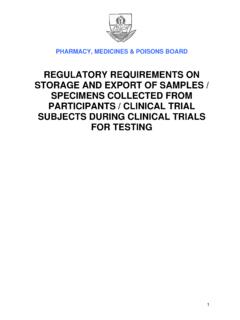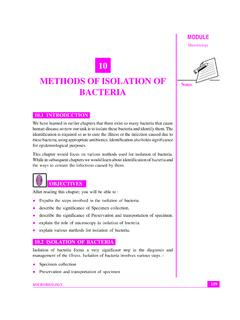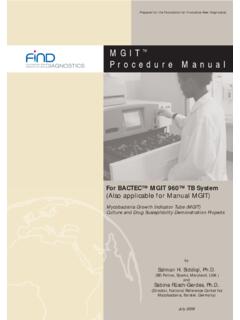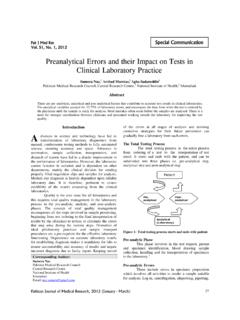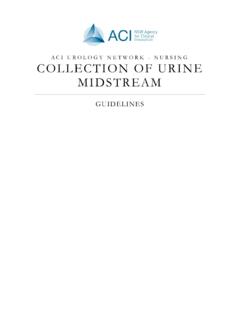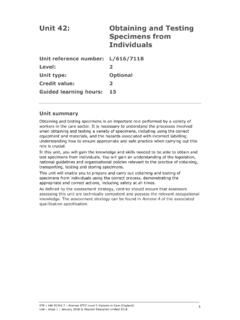Transcription of CAP Policy Manual Policy PP. Minimum Period of Retention of …
1 CAP Policy Manual Policy PP. Minimum Period of Retention of Laboratory Records and Materials The College of American Pathologists makes the following recommendations for the Minimum requirements for the Retention of laboratory records and materials. They meet or exceed the regulatory requirements specified in the Clinical Laboratory Improvement Amendments of 1988 (CLIA 88). It may be appropriate for laboratories to retain records and/or materials for a longer Period of time when required for patient care, education, quality improvement, medical/legal, or other needs, or if required by institutional Policy .
2 Some state regulations as well as other federal mandates may require Retention of records and/or materials for a longer time Period than that specified in the CLIA 88 regulations. For testing on minors (under the age of 21), stricter state regulations may apply. Therefore, any applicable national, federal, state (or provincial) or local laws should be reviewed carefully when individual laboratories develop their record Retention policies. Material/Record Period of Retention GENERAL LABORATORY. Accession records 2 years specimen requisitions (including the patient chart or medical record 2 years if used as the requisition).
3 Chain-of-custody collection , receipt, accessioning, and handling 2 years (or longer as applicable). records Quality management records 2 years Instrument/equipment maintenance and function check records 2 years (including temperature charts Proficiency testing records 2 years Policies and procedures 2 years following discontinuance Test method validation/verification records (method performance Length of time the test is in use, specifications) plus 2 additional years Quality control records 2 years Individualized Quality Control Plan (IQCP), including risk Length of time the test is in use, assessment and supporting data, and approval of quality control plus 2 additional years following plan discontinuation of the IQCP.)
4 Ongoing IQCP quality assessment data 2 years Laboratory Computer Services Computer system validation records 2 years beyond the life of the system Records of changes to software, the test library, and major 2 years beyond the life of the functions of laboratory information systems system Ongoing computer system checks (eg, calculation verification) 2 years Personnel Records Competency assessment records 2 years Training records 2 years Page 1 of 6 College of American Pathologists. All rights reserved. Material/Record Period of Retention SURGICAL PATHOLOGY (including bone marrows).
5 Wet tissue 2 weeks after final report Paraffin blocks (including cell blocks) 10 years Reports 10 years Slides Immunohistochemistry batch control slides 2 years Surgical pathology slides 10 years Bone marrows slides with associated peripheral blood smear(s) 10 years included in the bone marrow report Fluorochrome-stained slides At the discretion of the laboratory director In situ hybridization images (refer to NOTE 1) or permanent slides 10 years - Neoplastic disorders 20 years - Constitutional disorders Digital images used for primary diagnosis 10 years (if original glass slides are not available).
6 Digital images for Circulating Tumor Cells 10 years Datasets from ex-vivo microscopy (EVM) or in-vivo microscopy 10 years (data must be (IVM) systems used to aid in interpretation or diagnosis retrievable for this Period ). ELECTRON MICROSCOPY. Wet tissue 2 weeks after final report Resin blocks 10 years Pictures and reports 10 years CYTOLOGY. Reports 10 years Slides Immunochemistry batch control slides 2 years Gynecologic cytology glass slides 5 years Non-gynecologic cytology glass slides (including fine needle 10 years aspiration (FNA) slides NON-FORENSIC AUTOPSY.)
7 Wet tissue 3 months after final report Paraffin blocks 10 years (refer to for further detail). Slides 10 years Reports 10 years Autopsy consent 10 years FORENSIC AUTOPSY. Wet stock tissue 1 year Paraffin blocks 10 years Reports Indefinitely Slides 50 years or 30 years if a DNA sample is available Gross photographs/images Indefinitely Page 2 of 6 College of American Pathologists. All rights reserved. Material/Record Period of Retention Accession records Indefinitely Body fluids and tissues for toxicology 1 year Representative sample suitable for DNA Analysis Indefinitely Autopsy consent 10 years CLINICAL PATHOLOGY.
8 Testing Records Instrument printouts (not interfaced with laboratory computer 2 years system) and worksheets Patient test results and reports, including original and corrected 10 years reports, and referral laboratory reports Direct-to-consumer testing results, including reference intervals 10 years Patient Specimens Serum and plasma 48 hours; exceptions may be made at the discretion of the laboratory director. Longer storage requirements may be necessary for patients admitted for suspected drug overdoses. Citrated plasma At the discretion of the laboratory director (see ).
9 CSF and body fluids (except urine) 48 hours Whole blood specimens, including blood gas specimens At the discretion of the laboratory director Urine 24 hours; exceptions may be made at the discretion of the laboratory director Clinical Pathology Slides Peripheral blood films 7 days Permanently stained body fluid slides 7 days Permanently stained microbiology slides prepared from clinical 7 days specimens (including blood culture bottles). CYTOGENETICS. Final reports 10 years - neoplastic disorders 20 years - constitutional disorders Images (in situ hybridization (ISH) or non-ISH) (refer to NOTE 1)
10 10 years - neoplastic disorders 20 years - constitutional disorders Chromosomal microarray data 2 weeks after the final report is Original scan released Sufficient original data to support primary results generated and re- 2 years analysis Slides Permanently stained slides 3 years Fluorchrome stained slides At the discretion of the laboratory director Chromosomal microarray slides At the discretion of the laboratory director Page 3 of 6 College of American Pathologists. All rights reserved. Material/Record Period of Retention Original specimens and cultures Until release of the final report Processed specimens or cell pellets 2 weeks after final report MOLECULAR PATHOLOGY.



